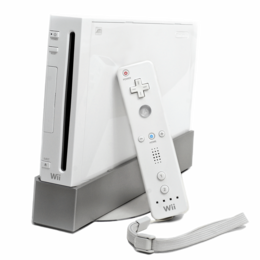The Wii (pronounced /ˈwiː/, like the pronoun we) is a home video game console released by Nintendo on November 19, 2006. As a seventh-generation console, the Wii primarily competes with Microsoft's Xbox 360 and Sony's PlayStation 3. Nintendo states that its console targets a broader demographic than that of the two others. As of December 2010, the Wii leads the generation over the PlayStation 3 and Xbox 360 in worldwide sales, and in December 2009 broke the record for best-selling console in a single month in the United States.
A distinguishing feature of the console is its wireless controller, the Wii Remote, which can be used as a handheld pointing device and detects movement in three dimensions. Another distinctive feature of the console is WiiConnect24, which enables it to receive messages and updates over the Internet while in standby mode.
The Wii is Nintendo's fifth home console, the direct successor to the Nintendo GameCube, and able to play all official GameCube games. Nintendo first spoke of the console at the 2004 E3 press conference and later unveiled the system at the 2005 E3. Nintendo CEO Satoru Iwata revealed a prototype of the controller at the September 2005 Tokyo Game Show. At E3 2006, the console won the first of several awards. By December 8, 2006, it had completed its launch in four key markets.
History
The console was conceived in 2001, as the Nintendo GameCube was first seeing release. According to an interview with Nintendo's game designer Shigeru Miyamoto, the concept involved focusing on a new form of player interaction. "The consensus was that power isn't everything for a console. Too many powerful consoles can't coexist. It's like having only ferocious dinosaurs. They might fight and hasten their own extinction."
Two years later, engineers and designers were brought together to develop the concept further. By 2005, the controller interface had taken form, but a public showing at that year's Electronic Entertainment Expo (E3) was withdrawn. Miyamoto stated that, "[W]e had some troubleshooting to do. So we decided not to reveal the controller and instead we displayed just the console." Nintendo president Satoru Iwata later unveiled and demonstrated the Wii Remote at the September Tokyo Game Show.
The Nintendo DS is said to have influenced the Wii design. Designer Ken'ichiro Ashida noted, "We had the DS on our minds as we worked on the Wii. We thought about copying the DS's touch-panel interface and even came up with a prototype." The idea was eventually rejected, with the notion that the two gaming systems would be identical. Miyamoto also expressed that, " if the DS had flopped, we might have taken the Wii back to the drawing board."
Name
The console was known by the code name of "Revolution" until April 27, 2006, immediately prior to E3. The Nintendo Style Guide refers to the console as "simply Wii, not Nintendo Wii", making it the first home console Nintendo has marketed outside of Japan without the company name featured in its trademark. While "Wiis" is a commonly used pluralization of the console, Nintendo has stated that the official plural form is "Wii systems" or "Wii consoles."
Nintendo's spelling of "Wii" with two lower-case "i" characters is meant to resemble two people standing side by side, representing players gathering together, as well as to represent the Wii Remote and Nunchuk. The company has given many reasons for this choice of name since the announcement; however, the best known is:
“ Wii sounds like 'we', which emphasizes that the console is for everyone. Wii can easily be remembered by people around the world, no matter what language they speak. No confusion. No need to abbreviate. Just Wii. ”
Despite Nintendo's justification for the name, some video game developers and members of the press reacted negatively towards the change. They preferred "Revolution" over "Wii" and Forbes expressed fear "that the name would convey a continued sense of 'kidiness' to the console." The BBC reported the day after the name was announced that "a long list of puerile jokes, based on the name," had appeared on the Internet. Nintendo of America's president Reggie Fils-Aime acknowledged the initial reaction and further explained the change:
“ Revolution as a name is not ideal; it's long, and in some cultures, it's hard to pronounce. So we wanted something that was short, to the point, easy to pronounce, and distinctive. That's how 'Wii,' as a console name, was created.”
Nintendo of America's then-Vice President of Corporate Affairs Perrin Kaplan defended its choice of "Wii" over "Revolution" and responded to critics of the name by stating, "Live with it, sleep with it, eat with it, move along with it and hopefully they'll arrive at the same place."
Launch
On September 14, 2006, Nintendo announced release information for Japan, North and South America, Australasia (Oceania), Asia and Europe, including dates, prices, and projected unit distribution numbers. It was announced that the majority of the 2006 shipments would be allotted to the Americas, and that 33 titles would be available in the 2006 launch window. The Wii was launched in the United States on November 19, 2006 at $249.99. It was later launched in the United Kingdom on December 8, 2006 at £179. The UK suffered a widespread shortage of console units as many high-street and online stores were unable to fulfill all pre-orders when it was released. The Wii was launched in South Korea on April 26, 2008 and in Taiwan on July 12, 2008.
skip to main |
skip to sidebar
Blog Artikel Teknologi Informasi (TI), Game, dan Design. Semoga Indonesia semakin maju.
Pages
About Me
- Arie Setiawan
- Arie Setiawan, pekerjaan sebagai Dosen di Fakultas Teknologi Informasi, UKSW - Salatiga. S2: Ilmu Komputer UGM S1: Teknik Elektro UKSW SMA : SMA Lab UKSW
Powered by Blogger.




